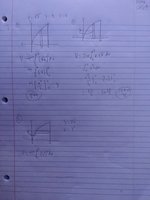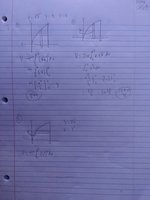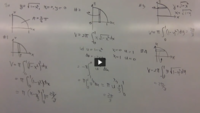You are using an out of date browser. It may not display this or other websites correctly.
You should upgrade or use an alternative browser.
You should upgrade or use an alternative browser.
Revolving around the x and y axis
- Thread starter pxnk
- Start date
D
Deleted member 4993
Guest
Please review "shell method" and "washer method" in your text-book or internet. Did you post the complete problem - exactly?So I am in Calculus I right now at university and I have no idea how to do these two problems... I am going to fail the class if I cannot do them, can anyone please help me do these. Thank you!
Please show us what you have tried and exactly where you are stuck.
Please follow the rules of posting in this forum, as enunciated at:
Please share your work/thoughts about this problem.
Math 1496 Calc 1 - Homework #12
Sketch the following regions and revolve each around the x and y axis using the method of washers and shells.
(i) y = √x, y = 0, x = 4
(ii) y = x^2 , y = 4x − x^2
Dr.Peterson
Elite Member
- Joined
- Nov 12, 2017
- Messages
- 16,873
Dr.Peterson
Elite Member
- Joined
- Nov 12, 2017
- Messages
- 16,873
Perhaps you are thinking of examples in which the same volume (that is, revolved around the same axis) can be found by either of the two methods, and will give the same result. That is not what you did here. You've done each volume in only one way.this is where I am, I have been following lecture notes, but his examples all have the same answer and I don't get the same answer on any of mine
I had wondered about the wording, which appears to tell you to do four things for each problem: revolve around the x-axis and find volume both ways, and then revolve around the y-axis and find volume both ways. You've done half of that.
Dr.Peterson
Elite Member
- Joined
- Nov 12, 2017
- Messages
- 16,873
these are the examples he has given to solve these two problems, from the work that I showed earlier am I on the right track? And the reason that he got the same volume is because he used sqrt1-x^2 as his function which makes sense now
Yes, he does each axis two ways, and all four are equal because both axes yield the same shape, a hemisphere.
As I said before (or implied?), your work was right, for the two parts you did, but you have two more parts to do.
Dr.Peterson
Elite Member
- Joined
- Nov 12, 2017
- Messages
- 16,873
Yes.I finished part i, but ii is different and I don't even know how to start it because it's two parabolas. should I just take the area between the curves on [0,2]? and then rotate them as I did previously?




